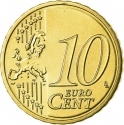You are about to finish your registration. Please check your mailbox (including spam folder). There should be a letter with a confirmation link. Check setting to make sure that your e-mail address is correct.
Send letter again
Obverse

|
The Brandenburg Gate, symbol of the division of Germany and its subsequent unification, is surrounded by the twelve stars of Europe. Mintmark and date below. ★ ★ ★ ★ ★ ★ ★ ★ ★ ★ ★ ★ |
|---|---|
Reverse

|
A geographical map of Western Europe spans the outer ring and inner core on the left side of the coin. 10 |
| Edge |
10 Euro Cent
1st map
KM# 210 Schön# 209 Jaeger# 485
Swap now (1 offer)
Characteristics
| Material | Nordic Gold |
| Weight | 4.1 g |
| Diameter | 19.75 mm |
| Thickness | 1.93 mm |
| Shape |
|
| Alignment | Medal |
| Mints |
Bavarian Central Mint (D) Berlin State Mint (A) Hamburg Mint (J) Karlsruhe State Mint (G) Stuttgart State Mint (F)
|



